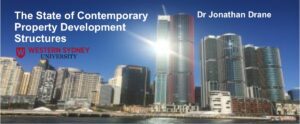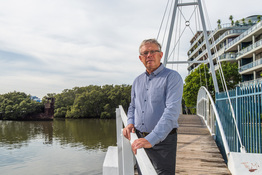The State of Contemporary Property Development Structures in the Australian Context
A Research Project by Dr Jonathan Drane, Sydney Graduate School of Management, Western Sydney University, Sydney, Australia. 2017.
![]()

Sydney CBD- Photo J Drane 2016

By Dr Jonathan Drane
Summary
This research explores the systemic historic deterioration of property development and construction practices, their structures and regulatory systems to explain and deter the tragic life threatening events that have arisen in our tall building commercial building sector. Read one page summary flyer:
Prop Dev Structures- Drane 2017
Background/Context
With the recent tragedies in Bankstown (Sydney), Grenfell (UK ), and the tower fire in Dubai, (UAE) ( see below) it has sadly taken the loss of innocent lives to move the building industry and statutory regimes of Australia toward a better regulatory and industry protocol that will mean that people are protected from such tragic outcomes in the multi-apartment dwellings and office towers they occupy.
It is also amazing to think that Australia with its world recognised BCA (Building Code of Australia) is still vulnerable to such incidents due to the decay in systems and protections that were once so strongly embedded in the Australian construction history since the inception of the BCA.
This research project ties in with the current industry movements for change and helps to explain the underlying structural reasons why the industry has become vulnerable to this epic and tragic event.
The project draws on my prior work related to property developer types, history of property development and their structures drawn from my doctorate and a related seminal paper on the state of contemporary development theory related to the topic:
Drane, J 2015, ;The Seed in the Cityscape: The Property Development Mechanism and its influence on the growth of cities, UNSWorks, Doctoral Thesis.
Link to UNSW Library for Published Doctorate
Drane, J 2013, ‘The state of contemporary property development theory’, Proceedings of 19th Annual Pacific-Rim Real Estate Society Conference, Melbourne, Australia.
Download Abstract:
Drane 2013- Abstract State of Contemporary Property Dev Theory
Drane 2013- State of Contemporary Prop Dev Theory
The project is also drawn from my work on building defects which is encapsulated in a key conference paper:
Drane, J 2015, ‘Building Defects, How can they be avoided?- a builder’s perspective’, Strata and Community Title in Australia for the 21st Century 2015 Conference.
Drane 2015- Defects A Builders View
When I presented this paper in 2015 at the Gold Coast Strata Community conference I had no idea how much impact it would have on revealing the history of decay of property development and construction structures and practices. I was the last speaker for the day (and the conference) and to my surprise people in the audience were lining up to ask questions. The press sought me out after the paper and before long my work was being reported on. I soon found myself being asked to participate in Office of Fair Trading workshops (2016) related to development practices and the controversial ‘Developer Bond’ a topic covered in my blog articles.
The key issue that I had missed that day in the Gold Coast was the disconnection of the audience from the knowledge I revealed. It was like I helped them enter a world they had never seen but only suspected.
As members of the Strata Community they were in effect the disconnected recipients of the completed strata schemes that our buildings encapsulate and which are delivered by remote control by the development and construction industry. During the property creation period there is little if no connect with the end purchasers except for an ‘umbilical-like’ pre-sale contract and a remotely appointed Body Corporate Manager who is selected by the Property Developer.
This tenuous link is one of the several key tenets of this study along with the decay in the delivery structures and processes that are intrinsic to the creation of a building or property by an often disinterested party. Developers are usually only interested in trading out of the project and not being vested in the end use, its care and operation. This is a second tenet but by no means explains the resultant product deficiencies that the system created that resulted in the likes of the loss of lives in the Bankstown and other examples.
Drane, J 2018, ‘The State of Contemporary Property Development Structures and Systems in Australia’, Building Regulatory Reform Summit, 2018, Building Products Innovation Council, ACT, Canberra, Australia.
Dr Drane covers the history of decay of property development systems and practices at the Building Regulatory Reform Summit.
Presentation By Dr Jonathan Drane Feb 2018
https://www.jondrane.net/research/the-state-of-contemporary-property-development-structures/building-regulatory-reform-summit-2018/
____________________________________________________________
Study Objectives
A pilot micro-study of the systemic causes behind the deterioration of industry practices and structures in the NSW construction and property development industry with a focus on multi-apartment dwellings initially. The pilot will inform and frame further substantial research of overall Australian systems with the view to securing defined and effective outcomes for implementation in the future.
Relevance
The study enhances our understanding of how current systems and practices have led to the deterioration of safety and quality in construction outcomes and defines a new regulatory and systemic structure for future property development and construction.
Proposed Study Fields
Multi-apartment developments in a selection of dense pre-sales marketplaces in the Sydney Basin.
Study Method
Survey, Case Study, Historical Analysis, Semi-structured interview reinforcing the author’s existing Defects Scenario Matrix which provides an analytical project risk framework. The study draws on the author’s existing doctoral study which included a history of property developer types, dynamics and practices along with property development industry structures.
______________________________________________________________________
For More Information on the Structures of Property Development
Several blog articles and web pages have also been created around the different issues relating to the property developer and property development practices which are showcased below and in our blog articles and example is below:
https://www.jondrane.net/publications/1405-2/
___________________________________________________________________________Tower Tragedies in Australia and Overseas:
2012 Bankstown incident. Two women jump from fifth floor balcony.
http://www.news.com.au/national/children-trapped-in-burning-building/news-story/97e3e33535847f1ce094ce106723a5f1
Lacrosse Docklands Tower 2014 : Stripped of combustible cladding
http://www.abc.net.au/news/2014-11-25/residents-evacuated-after-fire-in-melbourne-cbd-apartment-build/5914978
http://www.afr.com/real-estate/two-years-after-fire-melbournes-lacrosse-building-retains-aluminium-cladding-20170615-gwrpkd
http://www.theage.com.au/victoria/combustible-cladding-to-be-stripped-off-lacrosse-docklands-tower-20170116-gtslcj.html
Grenfell Tower Fire 2017
https://en.wikipedia.org/wiki/Grenfell_Tower_fire
Grenfell Tower 2017: Could this happen in Australia?
http://www.theage.com.au/victoria/london-tower-fire-could-happen-here-australian-buildings-cloaked-in-flammable-cladding-20170615-gws15r.html
Dubai Torch Tower2017: The residents thought it a false alarm
https://www.thenational.ae/uae/dubai-torch-tower-blaze-residents-thought-it-was-a-false-alarm-1.616755
___________________________________________________________________________
Relevant Links:
Link to UNSW Library for Published Doctorate
Research Sites – Jonathan Drane
___________________________________________________________________________
WSU Web Page Guidelines
![]()
This is a web page created by Dr Jonathan Drane in his capacity as a lecturer and researcher at Western Sydney University. It is created in accordance with the university’s social media policy and guidelines see link to pdf:
Media_Social_Media_and_Public_Commentary_Policy
